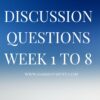Description
PSY 402 Midterm Exam Study Guide
- Describe the Emergence of the field of cognitive science in the 20th century (pg. 10, chapter 1).
- Define empiricism and associationism, and explain how these philosophies are reflected in the field of cognitive science. (pg 11-12 chapter 1)
- Briefly explain Donald Hebb’s Statement, “Cells that fire together, wire together.” What significance did this proposal have on neuroscience?
- Define myelin, the process of myelination, and the purpose of myelination. What happens when certain diseases cause demyelination?
- Describe the structure and functions of the following cells: Schwann Cells, glia, microglia, and neurons.
- Describe the structure of a neuron and the functions of its component parts.
- Explain the process of neuronal signaling, including membrane potential, threshold potential, and equilibrium potential (chapter 2; pg 27)
- List the primary excitatory and inhibitory neurotransmitters.
- Identify the relationship between sensation and area on the somatosensory cortex of the post-central gyrus (chapter 2; pgs 54)
- Identify the major lobes of the brain and the corpus callosum. What are the primary functions of the corpus callosum and lobes?
- Describe the following parts of the brain (including their component structures): Brainstem, diencephalon, and telencephalon. Briefly describe the primary function of each major component.
- Describe the location and purpose of the following brain structures; basal ganglia, pons, corpus callosum, limbic system psy 402 midterm exam
- Describe computed tomography- what is the purpose of a CT Scan, and what is the basic process for a scan?
- Describe positron emission tomography- what is the purpose of a PET scan, and what is the basic process for a scan?
- Identify the primary auditory cortex.
- Define rods and cones, including their functions and primary locations.
- Identify the primary visual pathway.
- Identify the primary olfactory pathway.
- Describe deficits in perception related to injuries in the optic nerves.
- Identify sympathetic and parasympathetic responses.

